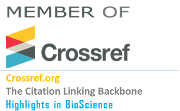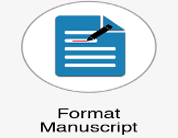Assessment of stress biomarkers responses in mantle and adductor muscles of Mactra stultorum following lead exposure
Abstract
The objective of the present work is to evaluate the possible toxic effect engendered by graded doses of lead chloride (PbCl2) on Mactra stultorum mantle and adductor muscles through a battery of biomarkers responses. M. stultorum were divided into 4 groups and exposed to three concentrations of PbCl2 (D1:1mg/L, D2: 2.5 mg/L and D3: 5 mg/L) with control during five days. Our findings showed decreases of lipid contents in both organs following PbCl2 exposure, while, proteins declined only in the adductor muscles of the treated M.stultorum. During our experiment, the PbCl2 exposure induced the levels of metallothionein (MTs), malondialdehyde (MDA) and advanced oxidation protein products (AOPP) in both organs as compared to the control. These biomarkers responses are distinctly different between mantle and adductor muscles.
Keywords
Full Text:
View Full TextReferences
Di Salvatore P, Calcagno JA, Ortiz N et al. Effect of seasonality on oxidative stress responses and metal accumulation in soft tissues of Aulacomya atra, a mussel from the South Atlantic Patagonian coast. Mar. Environ. Res.2013; 92:244-252.
Velez C, Figueira E, Soares AMVM et al. Accumulation and cellular partitioning of metals and As in the clam venerupis corrugata: Different strategies towards different elements. Chemosphere. 2016; 156:128-134.
Company R, Serafim A et al. Source and impact of lead contamination on d- aminolevulinic acid dehydratase activity in several marine bivalve species along the Gulf of Cadiz. Aqua. Toxicol. 2011; 10:146-154.
Ennouri R, Chouba L, Magni P et al. Spatial distribution of trace metals (Cd, Pb, Hg, Cu, Zn, Fe and Mn) and oligo-elements (Mg, Ca, Na and K) in surface sediments of the Gulf of Tunis (Northern Tunisia).Environ. Monit. Assess. 2010; 163: 229-239.
Jebali J, Chouba L, Banni M et al. Comparative study of the bioaccumulation and elimination of trace metals (Cd, Pb, Zn, Mn and Fe) in the digestive gland, gills and muscle of bivalve Pinna nobilis during a field transplant experiment. Elem. Med. Biol. 2014; 28: 212-217.
WHO. Heavy metals-environmental aspects. Environment Health Criteria, 1989; 85, Geneva, Switzerland.
Ben-Khedher S, Jebali J, Houas Z et al. Metals bioaccumulation and histopathological biomarkers in Carcinus maenas crab from Bizerta lagoon, Tunisia. Environ. Sci. Pollut.Res. 2013; https://doi.org/10.1007/s11356-013-2399-x.
Velma V, Tchounwou PB. Chromium-induced biochemical, genotoxic and histopathologic effects in liver and kidney of goldfish, Carassius auratus. Mutat Res. 2010; 698 (1-2): 43-51.
Chetoui I, Rabeh I, Bejaoui S et al. Fatty Acid profile and Oil quality index in Mactra corallina (Bivalvia, Mactridae) from the north coast of Tunisia. Grasas y Aceites.2019a; 70(1):1-10.
Chetoui I, Bejaoui S, Ghribi F et al. Annual variation of the biochemical composition, energy reserves and physiological indices in Mactra stultorum tissues from the Tunisian coasts. H. BioSci. 2020; 3 :1-12.
FAO Fiches. FAO d’identification des espèces pour les besoins de la pêche en Mediterrane et Mer Noir. Zone de pêche.1987 ; 33(I),pp, 760.
Charef A, Zamouri Langar N, Houas Gharsallah I. Stock size assessment and spatial distribution of bivalve species in the Gulf of Tunis. JMBA. 2012; 92: 179-186.
Rittschof D, McClellan-Green P. Molluscs as multidisciplinary models in environment toxicology. Mar. Pollut. Bull. 2005; 50:369-373.
Abdallah MAM. Bioaccumulation of Heavy Metals in Mollusca Species and Assessment of Potential Risks to Human Health. Bull. Environ. Contam. Toxicol. 2013; 90:552-557.
Chetoui I, Bejaoui S, Fouzai C et al. Effect of lead graded doses in Mactra corallina gills: antioxidants status, cholinergic function and histopathological studies. J. Drug. Des. Med. Chem. 2019a; 5 (1):1-9.
Chetoui I, Bejaoui S, Trabelsi W et al. Exposure of Mactra corallina to acute doses of lead: effects on redox status, fatty acid composition and histomorphological aspect. Drug. Chen. Toxicol. 2019d; https://doi.org/10.1080/01480545.2019.1693590.
Gret F, Serafim A, Bebianno M J. Antioxidant enzyme activities, metallothioneins and lipid peroxidation as biomarkers in Ruditapes decussatus? Ecotoxicology.2003; 12: 417-426.
Hsu PC, Guo Y. Antioxidant nutrients and lead toxicity. Toxicology. 2002; 180: 33-44
Flora G, Gupta D, Tiwari A. Toxicity of lead: a review with recent updates.Interd Toxicol,2012; 5 (2): 47-58.
Ercal N, Orhan HG, Nukhet AB. Toxic Metals and oxidative stress Part I: Mechanisms involved in Me-tal induced oxidative damage. Curr. Top. Med. Chem. 2002; 1(6):529-539.
Lesser M P. Oxidative stress in marine environments: biochemistry and physiological ecology. Annu. Rev. Physio. 2006; 68: 253-278.
Cherian MG, Chan HM.Biological functions of metallothionein -Areview. In: Suzuki K, Imura N, Kimura M (Eds.) Metallothionein III. Birkhuser Verlag: Basel,1993, pp. 479.
Margoshes M, Vallee BL.A cadmium protein from equine kidney cortex. J. Am. Chem. Soc. 1957; 79:4813-4814.
Olsson PE, Larsson A, Maage A et al. Induction of metallothionein synthesis in rainbow-trout, Salmo gairdneri, during long-term exposure to waterborne cadmium. Fish. Physiol. Biochem. 1989; 6: 221-229.
Cai L, Satoh M, Tohyama C et al. Metallothionein in radiation exposure: its induction and protective role. Toxicolology. 1999; 132: 85-98.
Viarengo A, Burlando B, Ceratto N et al. Antioxidant role of metallothioneins: a comparative overview. Cell. Mol. Biol. 2000; 46: 407-417.
Cavaletto M, Ghezzi A, Burlando B et al. Effect of hydrogen peroxide on antioxidant enzymes and metallothionein level in the digestive gland of Mytilus galloprovincialis. Comp. Biochem. Physiol. 2002; 131 (C): 447-455.
Canesi L, Lorusso LC, Ciacci C et al. Immunomodulation of Mytilus hemocytes by individual estrogenic chemicals and environmentally relevant mixtures of estrogens: in vitro and in vivo studies. Aquat. Toxicol. 2007; 81: 36-44.
Chalkiadaki O, Dassenakis M, Lydakis-Siantiris N et al. Tissue specific, time and dose dependence impact of Lead to a commercial marine Mediterranean organism. 11th Panhellenic Symposium on Oceanography and Fisheries, Mytilene, 2015, Lesvos Island, Greece.
Thyrring J. Juhl BK, Holmstrup M et al. Does acute lead (Pb) contamination influence membrane fatty acid composition and freeze tolerance in intertidal blue mussels in arctic Greenland? . Ecotoxicology. .2015; https://doi.org/10.1007/s10646-015-1539-0.
Lowry O H, Rosebrough NJ, Farr A.L, et al. Protein measurement with the folin phenol reagent. J. Exper. Mar. Biol. Ecol. 195; 12:103-118.
Goldsworthy GJ, Mordue W, Guthkelch J, Studies on insect adipokinetic hormones. Gen. Com .Endocr. 1972; 18 : 545-551.
Shibko S, Kaivistoinen P, Tratnyck C A et al. A method for the sequential quantitative separation and determination of protein , RNA . DNA .lipid and glycogena from a single rat liver homogenate a from a sub cellular fraction. Anal.Biochem. 1966;19: 514-528.
Draper HH, Hadley M. Malondialdehyde determination as index of lipid peroxidation. Methods. Enzymol.1990; 86: 421-431.
Kayali R, Cakatay U, Akcay T et al. Effect of alpha lipoic acid supplementation on markers of protein oxidation in post-mitotic tissues of ageing rat. Cell. Biochem. Function. 2006 ; 24:79-58.
Viarengo A, Ponzano E, Dondero F , et al. A simple spectrophotometric method for metallothionein evaluation in marine organisms: An application to Mediterranean and Antarctic molluscs. Mar. Environ. Res. 1997; 44:Â 69-84.Â
Viarengo A, Canesi L, Pertica M et al. Heavy metal effects on lipid peroxidation in the tissues of Mytilus galloprovincialis Lam. Comp. Biochem. Physiol. 1990; 97(C): 37-42.
Quintanar-Escorza MA, Gonzalez-Martınez MT, Navarro L et al. Intracellular free calcium concentration and calcium transport in human erythrocytes of lead-exposed workers. Toxicol. Appl. Pharmacol. 2007; 220: 1-8.
Dafre AL, Medeiros ID, Muller IC et al.Antioxidant enzymes and thiol /disulfide status in the digestive glands of the brown mussel Perna perna exposed to lead and paraquat. Chem.Biol. Interact. 2004; 149:97-105.
Trombini C, Fabbri E, Blasco J. Temporal variations in metallothionein concentration and subcellular distribution of metals in gills and digestive glands of the oyster Crassostrea angulata. Adv. Mar. Chem. 2010: 143-152.
Misra DS, Maiti R, Ghosh D. Protection of swimming -induced oxidative stress in some vital organs by the treatment of composite extract of Withania Somnifera, Ocimum Sanctum and Zingiber Officinalis in male rat. Afr. J. Trad, Complement. 2009; 6: 534-543.
Los DA, Murata N. Membrane fluidity and its role in the perception of environmental signals. Biochem. Biophys. Acta. 2004;1666 (1-2): 142-157.
Geret F, Serafim A, Barreira L et al. Response of antioxidant systems to copper in the gills of the clam Ruditapes decusscatus. Mar. Environ. Res. 2002; 54: 413-417.
Shenai-Tirodkar PS, Gauns MU, Mujawar M WA et al. Antioxidant responses in gills and digestive glands of oyster Crassostrea madras ensi (Preston) under lead exposure. Ecotoxicol. Environ. Safety. 2017; 142: 87-94.
Prevodnik A , Lilja K , Bollner T. Effects of copper or cadmium on protein expression response in Baltic Sea blue mussels (Mytilus edulis L.). Mar.Environ.Res.2006; 62:90-91
Bejaoui S, Telahigue K, Chetou I et al. Effects of lead exposure on redox status, DNA and histological structures in Venus verrucosa gills and digestive gland. Chem. Ecol. 2020Â ; https://doi.org/ 10.1080/0275 7540.2020.1742329
Amiard JC, Amiard-Triquet C, Barka S et al. Metallothioneins in aquatic invertebrates: Their role in metal detoxification and their use as biomarkers. Aquat. Toxicol. 2006; 76(2): 160-202.
Davis SR, Cousins RJ. Metallothionein expression in animals: a physiological perspective on function. J Nutr, 2000; 130:1085- 1088
Kumar D. Role of non-enzymatic antioxidants in stimulation of metallothionein against metal toxicity. Inter. J. Environ. Sci. Techno. 2012; 2 (3): 1596-1604.
Fang Y, Yang H, Liu B. Tissue-specific response of metallothionein and superoxide dismutase in the clam Mactra veneriformis under sublethal mercury exposure. Ecotoxicology. 2012; 21: 1593-1602.
Chalkiadaki O, Lydakis-Simantiris N, Dassenakis M. Lead accumulation and metallothionein induction in different tissues in mussels (M. galloprovincialis) and clams (C. chione) exposed to various Pb concentrations. Proceedings of the 13th International Conference on Environmental Science and Technology Athens. 5-7 September 2013, Greece.
Ponnusamy K, Sivaperumal P, Suresh M. et al. Heavy Metal Concentration from Biologically Important Edible Species of Bivalves (Perna viridis and Modiolus metcalfei) from Vellar Estuary, South East Coast of India. J. Aqua. Res. Dev. 2014; 5 (5):1000258-1000263.
DOI: https://doi.org/10.36462/H.BioSci.202101
Refbacks
- There are currently no refbacks.
Copyright (c) 2021 Chetoui et al.

This work is licensed under a Creative Commons Attribution 4.0 International License.
...........................................................................................................................................................
Other "Highlights in" Journals
Highlights in Bioinformatics, Highlights in Chemistry, Highlights in Science, Highlights in Microbiology, Highlights in Plant Science
........................................................................................................................................
International Library of Science "HighlightsIn" is an Open Access Scientific Publishers, aiming to science and knowledge support













